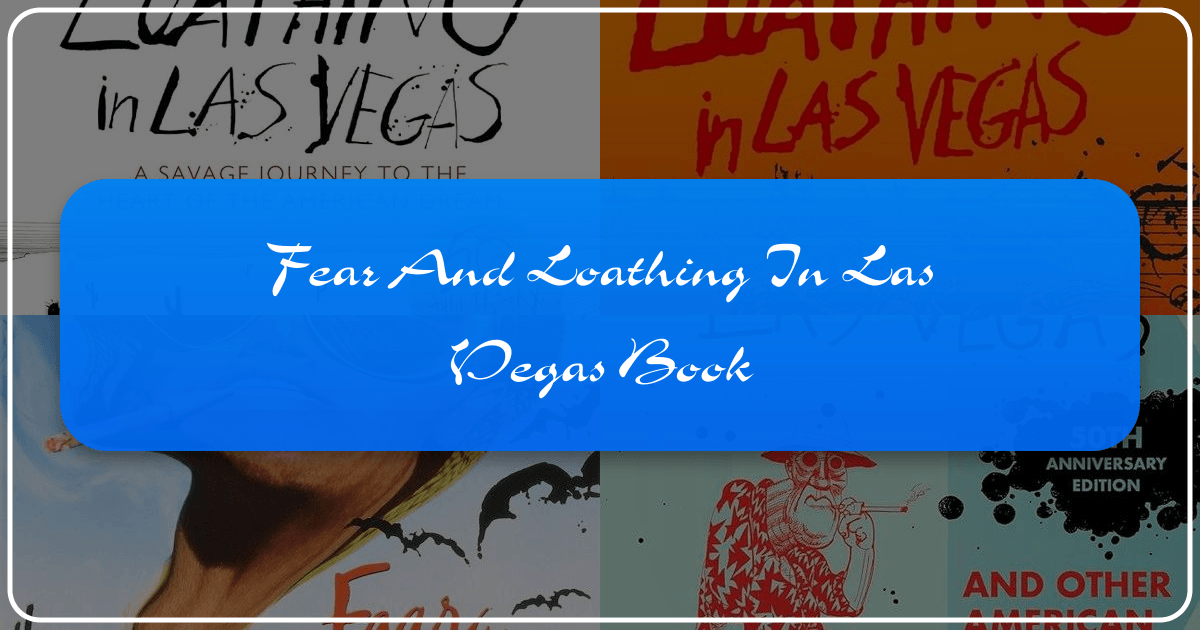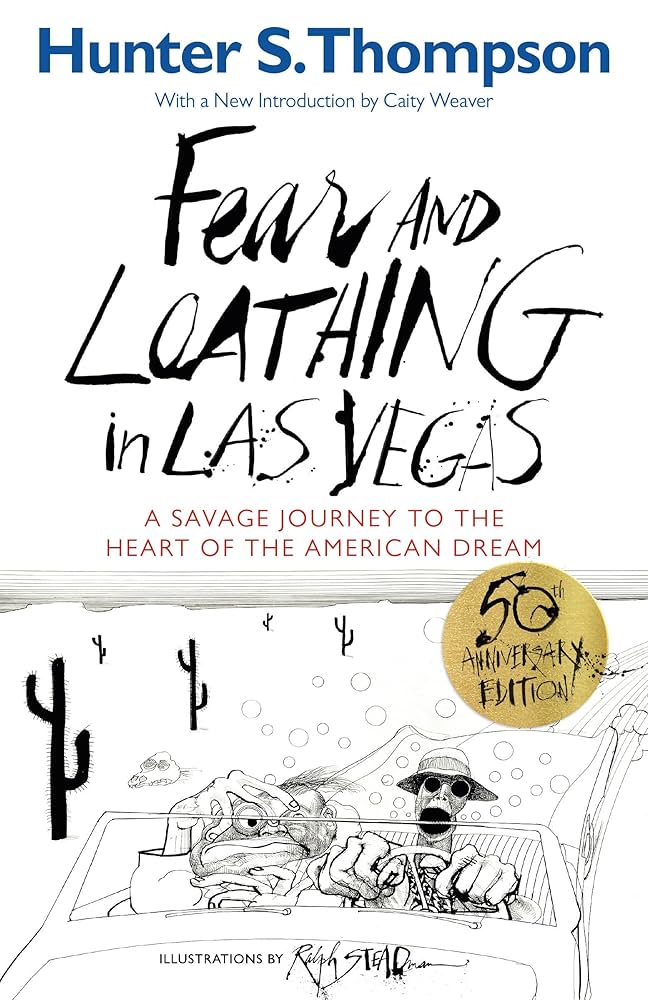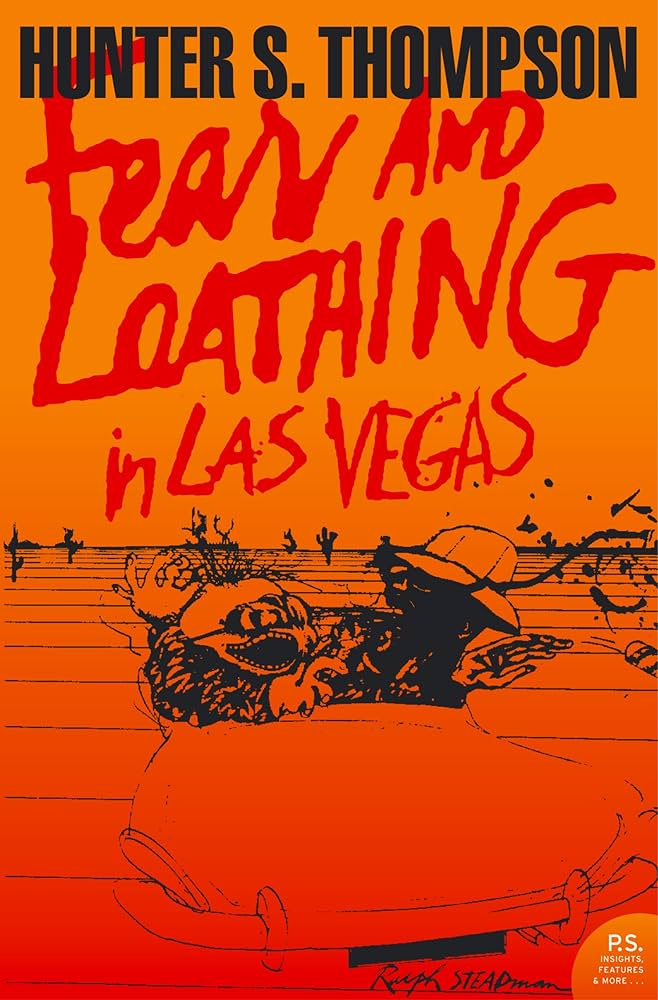Fear and Loathing in Las Vegas: A Deep Dive into Hunter S. Thompson's Masterpiece

Hunter S. Thompson’s Fear and Loathing in Las Vegas: A Savage Journey to the Heart of the American Dream is more than just a book; it’s a cultural phenomenon. This gonzo journalism masterpiece, first serialized in Rolling Stone magazine in 1971 and later published as a book in 1972, continues to resonate with readers and critics alike, influencing literature, film, and popular culture for decades. This in-depth exploration delves into various aspects of the book, examining its genre, author, impact, and legacy.
Genre and Literary Significance

Fear and Loathing in Las Vegas defies easy categorization. While rooted in journalistic reporting, its highly subjective, hallucinatory narrative, blending fact and fiction, firmly places it within the realm of gonzo journalism. This genre, largely pioneered by Thompson himself, immerses the author directly into the subject matter, blurring the lines between observer and participant. The result is a raw, unfiltered portrayal of experience, often characterized by a chaotic, stream-of-consciousness style.

The book’s significance extends beyond its genre. It’s considered a postmodern classic, challenging traditional narrative structures and literary conventions. The fragmented storyline, infused with dark humor, paranoia, and vivid sensory detail, creates a disorienting and intensely visceral reading experience. The novel’s loose structure reflects the drug-induced state of its protagonists, mirroring their chaotic journey through the underbelly of Las Vegas. It’s a stylistic tour de force, utilizing a frenetic, almost manic prose style that perfectly captures the frenetic energy of its subject matter.
Furthermore, the book transcends its immediate setting, becoming a powerful commentary on American culture and the disillusionment of the post-1960s era. Thompson’s cynical yet insightful observations on the American Dream, societal decay, and the corrosive effects of power, continue to resonate with contemporary readers. It’s not merely a wild ride; it’s a biting satire of American society and its pursuit of an elusive ideal.

The Role of Drugs and Hallucination
The pervasive presence of drugs in Fear and Loathing is not merely a stylistic device but a central theme, shaping the narrative’s structure and its meaning. The protagonists’ drug-fueled experiences distort reality, creating a hallucinatory landscape that reflects their own internal states and the broader societal anxieties of the time. The drugs become a catalyst for Thompson’s exploration of paranoia, alienation, and the breakdown of societal norms. This blurring of reality is not mere chaos; it’s a deliberate literary strategy used to convey the psychological and societal decay Thompson saw around him. The subjective nature of the narrative emphasizes the unreliability of perception under the influence and the difficulty of discerning truth from hallucination. This reflects the uncertainties and anxieties of the time period, where trust in established institutions and societal values was increasingly challenged.
Author and Inspirations
Hunter S. Thompson, a controversial and highly influential figure in American literature and journalism, was the driving force behind Fear and Loathing. His distinctive writing style, a blend of journalistic precision and vivid, often over-the-top prose, is immediately recognizable. He was renowned for his sharp wit, fearless reporting, and relentless pursuit of truth, even if that truth was elusive and often uncomfortable. Thompson’s personal experiences with drugs and his involvement in countercultural movements heavily informed his writing, shaping the perspective and tone of Fear and Loathing.
Hunter S. Thompson’s Writing Style
Thompson’s writing is characterized by its energy, intensity, and highly personal perspective. He masterfully employs vivid imagery, satire, and hyperbole, creating a compelling and often chaotic narrative. His prose is frenetic, reflecting the drug-induced state of his protagonists and the societal disintegration he critiques. He expertly blends elements of fiction and non-fiction, creating a unique and compelling blend known as gonzo journalism. He was not just a reporter, but a participant-observer, his emotions and reactions integral to the storytelling. This personalized style allowed Thompson to convey raw experience and emotion in a way that traditional journalism often failed to do.
The Collaboration with Ralph Steadman
Ralph Steadman’s illustrations are integral to the book’s impact. His grotesque and nightmarish drawings, complementing Thompson’s text, enhance the book’s hallucinatory atmosphere and add another layer of meaning. Steadman’s unique style captures the disjointed, paranoid world created by Thompson’s words, enhancing the overall impact. The illustrations are not merely decorations; they contribute significantly to the narrative, acting as visual counterparts to the textual chaos and adding a darker, more visceral dimension to Thompson’s already intense prose.
Reading and Learning from Fear and Loathing
While Fear and Loathing in Las Vegas is not a traditional self-help book, it offers profound insights into the human condition. The novel’s exploration of drug addiction, paranoia, disillusionment, and the search for meaning resonates deeply with readers on multiple levels. Thompson’s self-destructive tendencies and his struggle with the decline of American ideals serve as a cautionary tale, prompting readers to examine their own values and priorities.
Educational Value and Life Lessons
The book’s lasting impact stems from its insightful exploration of social and political themes, particularly the disillusionment felt by a generation grappling with the aftermath of the 1960s countercultural movement and its failure to achieve its stated goals. It can be seen as a powerful commentary on the human condition—the search for meaning, the dangers of self-destruction, and the pervasive influence of societal forces. Though the themes are presented through a highly stylized lens, they are fundamentally relatable and thought-provoking. The narrative’s power lies in its ability to take the reader on an emotional and intellectual journey, compelling them to confront the darker aspects of human experience and to consider the broader implications of their personal choices.
Reading Habits and Engagement
Fear and Loathing challenges the typical reading experience. Its chaotic structure, frenetic prose, and disorienting narrative require active engagement from the reader. The book’s intense and immersive narrative style demands an active reader, making it a challenging but ultimately rewarding experience. Its exploration of complex social and personal themes compels deep reflection and critical thinking. The novel’s legacy demonstrates how unconventional storytelling can profoundly impact readers and spark dialogue about important social issues.
Libraries and Archives
Given its status as a literary and cultural touchstone, Fear and Loathing in Las Vegas is undoubtedly housed in numerous libraries and archives worldwide. Public libraries would likely feature it in their fiction, classics, and possibly even their social commentary sections. Digital libraries provide convenient access to both the text and potentially audio adaptations. Rare book collections and archives may hold original editions or manuscripts, offering researchers invaluable insight into Thompson’s creative process and the genesis of the novel. The book’s availability in various formats—print, digital, and audio—ensures its accessibility to a broad audience, solidifying its place within literary and cultural history.
Cultural Impact and Legacy
Fear and Loathing in Las Vegas has left an indelible mark on popular culture. Its influence is evident in numerous film adaptations, graphic novel adaptations, and references in other works of literature, music, and video games. The book’s influence on popular culture is widespread, with many works directly referencing or drawing inspiration from its style, themes, and visual imagery.
Film and Other Adaptations
The 1998 film adaptation directed by Terry Gilliam, starring Johnny Depp and Benicio del Toro, is arguably the most famous adaptation of the novel. While not a direct translation of the source material, it captures much of the book’s hallucinatory atmosphere and chaotic energy. It’s a testament to the book’s enduring power and its adaptability to different artistic mediums. In addition to the film, there’s also a graphic novel adaptation that provides a different interpretative lens for readers. This demonstrates the breadth and depth of the book’s influence, permeating not just cinema, but also the graphic novel medium. Further demonstrating the enduring reach of the novel is the number of music videos and album titles that take inspiration from the text and/or film.
Awards and Recognition
While the novel may not have received traditional literary awards in the same way as more conventional works, its widespread influence and enduring popularity speak volumes about its impact. Its inclusion in various anthologies and its consistent presence in bestseller lists highlight its significant cultural footprint. The novel’s enduring impact comes not from formal awards, but from the recognition it receives through popular culture, film adaptations, and its continual presence in discussions about literature and society.
Communities and Fan Culture
Fear and Loathing has fostered a devoted fan base, resulting in rich communities dedicated to discussing and celebrating the novel’s themes, style, and cultural legacy. Online forums, social media groups, and academic discussions keep the book’s themes alive, illustrating how such a controversial piece can continue to attract debate and appreciation even years after its release.
In conclusion, Fear and Loathing in Las Vegas stands as a unique and influential work of literature, deeply embedded in American culture. Its lasting impact stems not only from its unique genre-bending style but from its insightful commentary on society, its exploration of the human condition, and its widespread influence across multiple artistic mediums. Its continued discussion and analysis further highlight its lasting legacy in both literary and cultural landscapes.